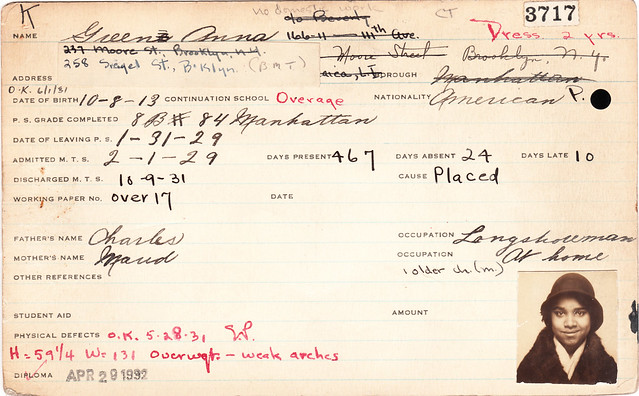
Before we get to today's post, one quick order of business: I've taken the first entry on this blog and repurposed it as an "About Permanent Record" page. That page, along with the full list of all 395 students whose report cards I have, is linked in the right sidebar.
Now then … The Manhattan Trade School for Girls was unusual because it had a job placement office that helped the girls secure jobs (mostly garment-related, because most of the students were trained in sewing or dressmaking) after they graduated. The girls and the employers were encouraged to report back on each other, and all those reports were documented in the students' files. This information is some of the most compelling material in the report cards, because you can see little dramas and storylines playing out.
One such story involved Anna Green, a dressmaking student who attended Manhattan Trade from 1929 through 1931 (the front card of her student record is shown at the top of this page; you can see the rest of her file in this slideshow). Anna faced a lot of challenges: Her mother had left the Green household when Anna was four. When her father, a longshoreman, had trouble finding work during the Depression, he could no longer provide for Anna and sent her to live with friends. The school found some positions for her, but her stint at a blouse and scarf manufacturer called E. Vonder Esch just compounded her problems, as seen in this series of exchanges she had with with school's job placement director:
May 3, 1933: Vonder Esch out of business and owes employees three weeks salary. Attorney already on the case.
Oct. 31, 1933: Received a check for $1.73 for my services at Vonder Esch. Can you give me some information on this?
Nov. 2, 1933: You may get more from the Vonder Esch bankruptcy. It depends on what they realized from the sale of the business. Why don't you communicate with the attorney?
Dec. 6, 1933: Earn $25 a month. Five dollars of this each week has to be contributed at home, and the rest is used up for carfares. This leaves almost nothing for clothes. Home conditions are unbearable and will continue to be so until I can give more. Mrs. Schachter [Anna's employer at the time] has refused me a raise, saying she cannot pay any more. Shall I look for a job now or after Christmas?
Dec. 8, 1933: Stay with Mrs. Schacter for the present. There are no jobs now.
Dec. 13, 1933: Telephoned attorney Baer regarding the remainder of the back salary due me from Vonder Esch. Was informed that I had received my share of the Vonder Esch estate. Feel as if I've been cheated. How can I find out if this was a just settlement?
Dec. 15, 1933: I told you before how bankruptcy cases are settled. I'm sure there is no fraud here. It simply means that, after settlement, there was very little to divide among the creditors.
The school continued to find jobs for Anna for the next four years. I wasn't able to locate her family, so it's not clear what happened to her after that.
The report cards are full of unresolved stories like this one. Many more of them will be presented in the series of Permanent Record articles that will appear on Slate next month.

That is disgusting that she received $1.73 for all of her hard work at Vonder Esch. I feel angry and cheated for her. I hope everything worked out eventually for Anna. She had a tough road to travel.
ReplyDelete